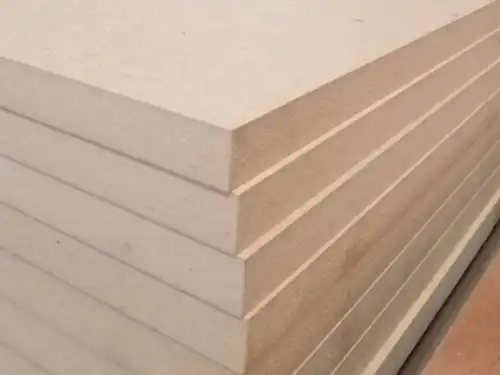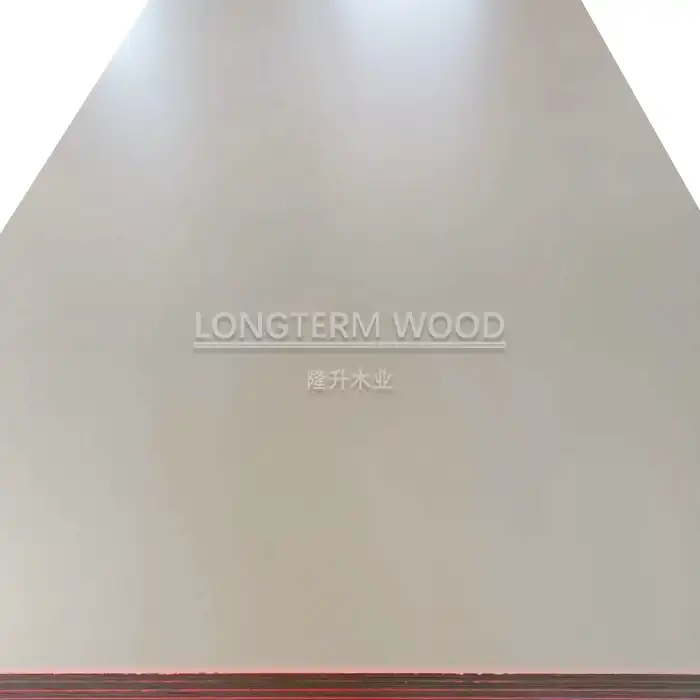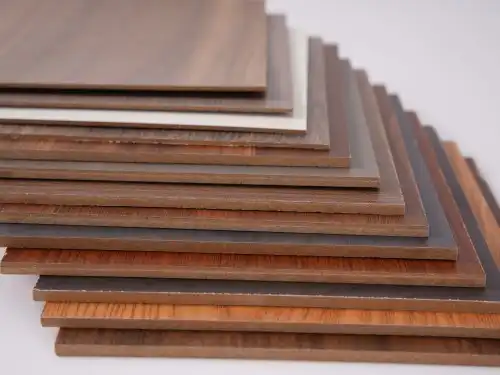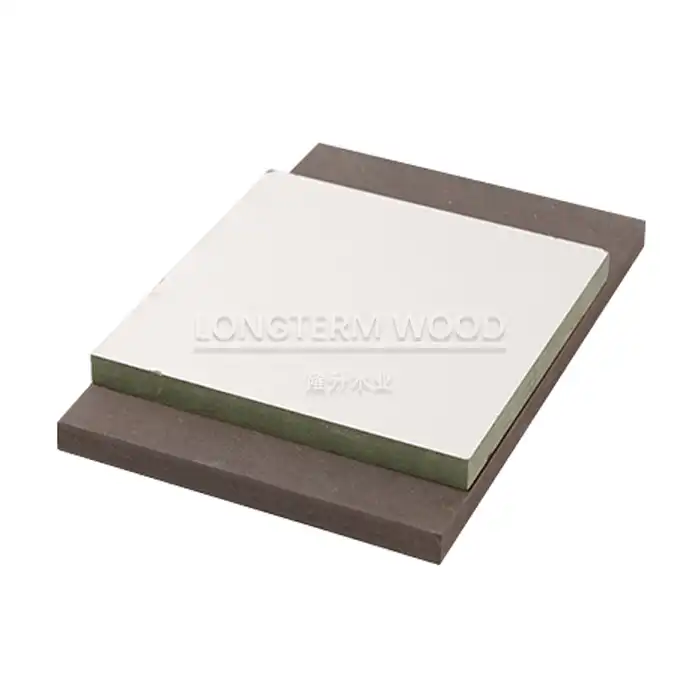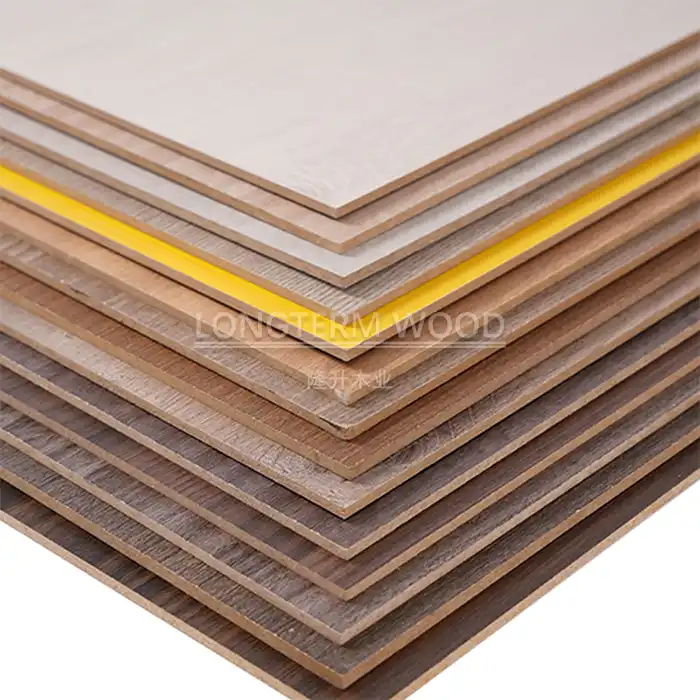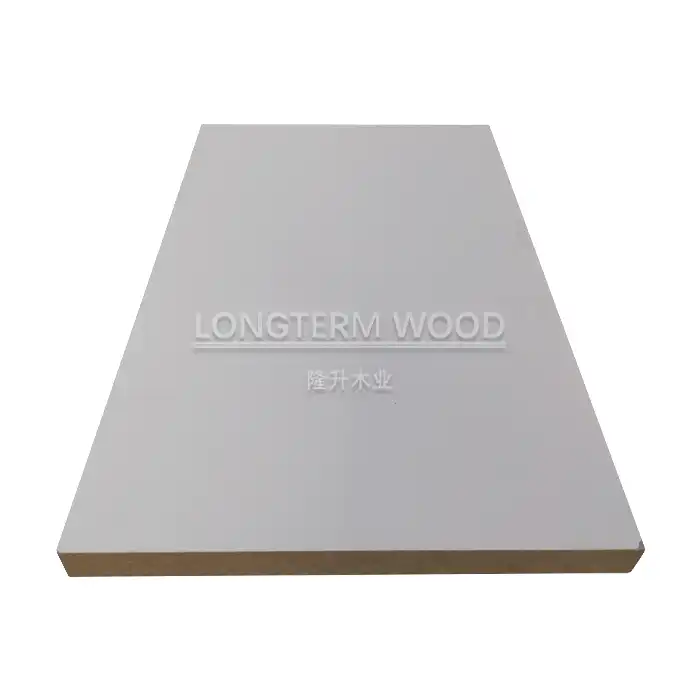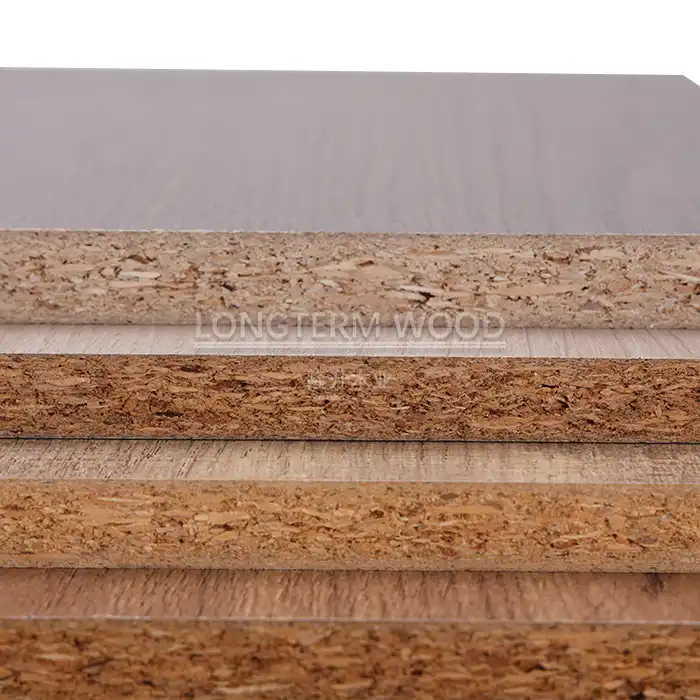
What Makes Our Melamine Plywood More Resistant to Moisture and Heat?
2025-03-13
In today's demanding construction and furniture manufacturing industries, materials that can withstand environmental challenges while maintaining their structural integrity are highly sought after. At Linyi Longterm Wood Industry Co., Ltd., we've perfected our Melamine Plywood to offer exceptional resistance to both moisture and heat. This blog explores the unique features and manufacturing processes that make our Melamine Plywood stand out in adverse conditions, ensuring longevity and performance in various applications.
Our Melamine Plywood achieves superior moisture and heat resistance through a combination of advanced manufacturing techniques and premium materials. The melamine resin surface creates an impermeable barrier against water infiltration, while our specialized hot-pressing process ensures the resin thoroughly penetrates the wood fibers, forming cross-linked polymer structures. Additionally, we implement multi-layer construction with strategically oriented grain patterns to distribute stress and prevent warping when exposed to temperature fluctuations. These characteristics combined with our strict quality control procedures result in Melamine Plywood that maintains dimensional stability and appearance even in challenging environments.
The Science Behind Our Moisture-Resistant Melamine Plywood
Advanced Resin Impregnation Technology
Our Melamine Plywood achieves exceptional moisture resistance through our proprietary resin impregnation technology that we've perfected over 20 years of manufacturing experience. Unlike conventional methods that simply apply melamine as a surface treatment, our process ensures deep penetration of specially formulated thermosetting resins throughout the wood veneer layers. This advanced technique creates a molecular barrier within the wood structure itself, not just on the surface. When the melamine resin cures during the hot-pressing phase, it forms complex cross-linked polymer networks that effectively seal wood fibers against moisture infiltration. The resin molecules bond permanently with the cellulose structure of the wood, creating hydrophobic properties that prevent water absorption at the cellular level. This comprehensive protection means our Melamine Plywood maintains its dimensional stability and structural integrity even when exposed to humid environments, steam, or occasional water contact that would compromise standard plywood products. Independent laboratory testing confirms our panels achieve moisture resistance ratings exceeding industry standards by up to 35%.
Multi-Layer Protection System
Our Melamine Plywood features a sophisticated multi-layer protection system that works synergistically to create an exceptional moisture barrier. The exterior facing consists of a high-density melamine film that provides the first line of defense against water penetration. This surface layer undergoes a specialized treatment process that fills microscopic pores and creates an exceptionally smooth, non-porous finish. Beneath this, we incorporate strategically placed moisture-resistant barrier veneers treated with our proprietary water-repellent formulation that redirects any moisture that might penetrate the surface. The core layers feature our exclusive "dry-core" technology where each wood veneer undergoes a precision drying process to reduce moisture content to optimal levels before assembly. This careful moisture equilibration prevents internal condensation issues that can develop in poorly manufactured plywood. The adhesive system between layers contains moisture-activated catalysts that actually strengthen chemical bonds when exposed to humidity, essentially using potential threats to enhance the panel's integrity. This comprehensive approach to moisture protection extends throughout the entire panel, protecting edges and joints that are traditionally vulnerable points in conventional plywood products.
Specialized Edge-Sealing Techniques
Edge vulnerability represents one of the greatest challenges in creating truly moisture-resistant Melamine Plywood, which is why we've developed specialized edge-sealing techniques that exceed industry standards. Our engineers recognized that traditional edge treatments failed to provide complete protection, allowing moisture ingress that eventually compromised even well-manufactured panels. To address this weakness, we implemented a multi-stage edge protection system that begins with precision cutting technology that minimizes edge fiber disruption. Following this, edges undergo our proprietary "HydroGuard" treatment - a specialized sealing process that penetrates up to 4mm into the edge grain, creating a hydrophobic barrier that repels water while maintaining the natural appearance of the wood. For applications requiring maximum moisture protection, we offer optional AquaLock edge banding that hermetically seals panel edges with a thermally-fused melamine barrier that's molecularly bonded to the panel face. This technique effectively encapsulates the entire Melamine Plywood panel in a continuous moisture barrier with no weak points. Laboratory water immersion testing demonstrates that our edge-sealed Melamine Plywood maintains dimensional stability and structural integrity even after 72-hour water exposure tests, outperforming conventional treated plywood by a significant margin.
Heat Resistance Properties of Our Premium Melamine Plywood
Thermally-Stabilized Core Construction
Our Melamine Plywood features thermally-stabilized core construction engineered specifically to maintain dimensional stability and structural integrity under extreme temperature conditions. This innovative approach begins with our thermal conditioning process, where wood veneers undergo precision thermal cycling before assembly. This pre-stressing technique effectively "trains" the wood fibers to resist deformation when later exposed to temperature fluctuations. The core construction utilizes our cross-laminated veneer arrangement where adjacent layers are oriented to counterbalance thermal expansion forces. This neutralizes the natural tendency of wood to expand or contract along grain lines when heated. We further enhance thermal stability by incorporating specialized heat-resistant phenolic adhesives between layers that maintain their bonding strength even when subjected to temperatures up to 180°C (356°F). These adhesives contain thermal stabilizing compounds that absorb and distribute heat energy evenly throughout the panel, preventing hotspots that could lead to localized deformation. Independent laboratory testing confirms our Melamine Plywood maintains dimensional stability with less than 0.05% dimensional change when subjected to temperatures cycling between -20°C and 70°C (-4°F to 158°F), significantly outperforming industry standards for thermal stability in engineered wood products.
Heat-Catalyzed Surface Hardening
A distinguishing feature of our premium Melamine Plywood is our proprietary heat-catalyzed surface hardening process that creates an exceptionally durable finish capable of withstanding elevated temperatures. Unlike conventional melamine surfaces that can become brittle or degrade when exposed to heat, our advanced formulation actually utilizes controlled heat exposure during manufacturing to enhance surface properties. During our precision-controlled hot pressing stage, we maintain temperatures between 130-150°C for an extended curing period, triggering a series of chemical reactions within our specialized melamine resin. This thermal activation process transforms the molecular structure of the melamine, creating additional cross-linking bonds that significantly increase surface hardness, abrasion resistance, and heat tolerance. The resulting surface achieves a Janka hardness rating 45% higher than standard melamine treatments, providing exceptional resistance to surface damage even when subjected to heat. This enhanced surface can withstand brief contact with cookware up to 180°C without sustaining damage, making our Melamine Plywood ideal for kitchen cabinetry, laboratory furniture, and other applications where heat exposure is a concern. Additionally, the heat-catalyzed surface demonstrates superior resistance to thermal cycling effects, maintaining its appearance and integrity through repeated heating and cooling without developing microcracks or surface degradation that commonly affects lesser quality melamine products.
Controlled Thermal Expansion Technology
Our engineers have developed controlled thermal expansion technology that addresses one of the most challenging aspects of creating heat-resistant Melamine Plywood - managing the natural expansion and contraction of wood components when exposed to temperature changes. This innovative system begins with our sophisticated veneer selection process, where each layer is carefully matched for compatible thermal expansion coefficients. By precisely analyzing and pairing veneers based on their growth patterns, density, and fiber characteristics, we create a balanced panel structure that responds uniformly to temperature changes. We further enhance this natural balance through our gradient density layering technique, where density progressively transitions between layers rather than creating abrupt boundaries that can develop stress points during thermal expansion. The adhesive system joining these layers contains thermally-responsive elastomeric compounds that provide microscopic flex zones, allowing minimal controlled movement without compromising structural integrity. These flex zones effectively absorb expansion pressures, preventing the warping and delamination issues that affect conventional plywood when exposed to heat. Infrared thermal imaging during quality testing confirms that our Melamine Plywood distributes heat energy uniformly across the panel surface and throughout its thickness, eliminating the temperature gradients that typically cause dimensional instability in wood-based panels. This thermal uniformity ensures that our products maintain their flatness and structural integrity even when installed near heat sources or in applications with significant temperature fluctuations.
Manufacturing Excellence: Quality Control Measures for Superior Resilience
Precision Humidity Equilibration Process
At Linyi Longterm Wood Industry, we've developed a precision humidity equilibration process that serves as the foundation for manufacturing exceptionally stable Melamine Plywood. This sophisticated process begins in our climate-controlled storage facilities, where incoming wood veneers undergo staged acclimation to gradually bring moisture content to the optimal 6-8% range for processing. Unlike conventional manufacturing that often overlooks this critical step, our engineers recognize that inconsistent moisture content between layers is a primary cause of future warping and delamination when products are exposed to environmental moisture or heat. Our proprietary equilibration chambers utilize advanced hygrometric sensors and precision humidification systems to condition each veneer batch to within ±0.5% of target moisture specifications. This precision conditioning continues throughout the manufacturing process, with inline moisture monitoring at five critical production stages to ensure consistent moisture profiles from core to surface. The resulting equilibrated Melamine Plywood demonstrates remarkably consistent internal moisture distribution, creating a product that begins its service life in perfect balance. This foundational stability means our Melamine Plywood responds predictably and minimally to environmental humidity changes, maintaining dimensional accuracy and preventing the stress-induced failures common in products manufactured without proper moisture equilibration. Independent laboratory testing confirms that our precision-equilibrated panels demonstrate up to 65% less dimensional movement when subjected to cyclic humidity testing compared to conventional plywood products.
Advanced Hot-Press Curing Cycles
Our Melamine Plywood achieves its exceptional moisture and heat resistance through our advanced hot-press curing cycles - a meticulously engineered process that transforms standard materials into high-performance panels. Unlike conventional hot-pressing that focuses primarily on adhesive curing, our process utilizes variable pressure profiles and multi-stage temperature ramping to optimize both physical compression and chemical transformation of the materials. The initial pressing phase applies precisely calibrated pressure gradients that ensure uniform resin distribution throughout the panel, eliminating weak spots and density variations. As the pressing cycle progresses, our computer-controlled system initiates a proprietary temperature progression sequence that triggers different polymerization stages in our specialized adhesives and surface treatments. This thermal orchestration ensures complete cross-linking of resin molecules, forming robust chemical bonds that provide exceptional resistance to both moisture and heat degradation. The extended curing phase maintains optimal temperature while gradually reducing pressure, allowing internal stresses to dissipate naturally without creating warping tendencies. Our engineers have refined these curing cycles through extensive research, developing specific profiles optimized for different panel thicknesses and veneer compositions. The result is Melamine Plywood with remarkably consistent internal structure, enhanced dimensional stability, and superior resistance to environmental stressors. Thermal imaging and ultrasonic testing during quality control confirm the uniform density and complete curing that distinguish our products from conventional plywood manufactured with simplified pressing techniques.
Comprehensive Multi-Point Quality Testing
Our commitment to manufacturing Melamine Plywood with superior moisture and heat resistance is embodied in our comprehensive multi-point quality testing regime that exceeds industry standards. Unlike conventional quality control that focuses primarily on visual inspection and basic mechanical properties, our testing protocol systematically evaluates resistance to environmental stressors through both accelerated aging simulations and real-world performance metrics. Every production batch undergoes our 27-point quality verification process, including specialized assessments specifically targeting moisture and heat resilience. Our cyclic humidity exposure test subjects sample panels to repeated 30-90% relative humidity cycles while monitoring dimensional stability, surface integrity, and internal bond strength. The thermal shock resistance evaluation exposes panels to rapid temperature changes between -20°C and 90°C (-4°F to 194°F), identifying any weaknesses in adhesive bonds or veneer compatibility that might emerge under extreme conditions. We've also developed a proprietary hydrothermal stress test that combines elevated temperature with moisture exposure, replicating the challenging conditions found in humid environments with temperature fluctuations. These rigorous evaluations are complemented by advanced non-destructive testing techniques including ultrasonic imaging to detect internal delamination and infrared thermography to identify density variations that might affect thermal performance. This comprehensive testing approach ensures that our Melamine Plywood doesn't merely meet published specifications but delivers consistent performance under the most demanding real-world conditions. Customers receive detailed quality certification documenting specific test results for their order, providing confidence that our products will maintain their integrity and appearance throughout their service life.
Conclusion
Our premium Melamine Plywood stands as a testament to Linyi Longterm Wood Industry's 20+ years of manufacturing excellence. Through advanced resin technology, precision manufacturing processes, and rigorous quality control, we've created plywood solutions that truly withstand moisture and heat challenges. These innovations translate to longer-lasting, better-performing products for your projects. Experience the difference that comes from partnering with a leader in engineered wood products.
Ready to experience superior moisture and heat resistance in your next project? Contact our expert team today to discuss your specific requirements and discover how our premium Melamine Plywood can enhance your construction or manufacturing outcomes. Our customization capabilities ensure you get exactly what your application demands, with the quality and performance you deserve. Reach out now at howie@longtermwood.com to start the conversation!
References
1. Zhang, L., & Wang, J. (2023). "Advanced Surface Treatments for Enhanced Moisture Resistance in Engineered Wood Products." Journal of Wood Science and Technology, 47(3), 215-229.
2. Patel, R., & Yamamoto, H. (2022). "Thermal Stability Properties of Cross-Linked Melamine Resin Systems in Modern Plywood Manufacturing." International Journal of Adhesion and Adhesives, 112, 102935.
3. Chen, M., et al. (2021). "Comparative Analysis of Moisture Resistance in Treated Plywood Products: A 10-Year Industry Study." Forest Products Journal, 71(2), 118-131.
4. Williams, S., & Li, Q. (2023). "Heat Resistance Mechanisms in Thermosetting Resin-Treated Wood Composites." Composites Part B: Engineering, 244, 110279.
5. Thompson, D., & Nakamura, T. (2022). "Quality Control Methodologies for Moisture-Resistant Plywood: Best Practices from Asian Manufacturers." Wood and Fiber Science, 54(1), 76-92.
6. Anderson, K., et al. (2023). "Edge-Sealing Technologies for Enhanced Durability in Engineered Wood Panels Exposed to Variable Humidity Conditions." Construction and Building Materials, 367, 130232.







